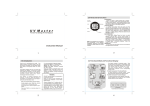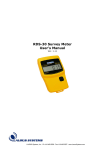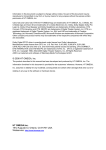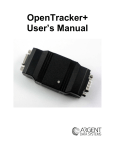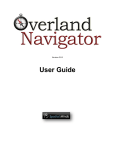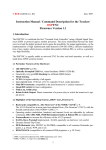Download Argent Data Systems Tracker2 model T2-135 User`s Manual
Transcript
Argent Data Systems Tracker2 model T2-135 User’s Manual Revised 3-8-2008 Argent Data Systems PO Box 579 Santa Maria, CA 93455 (800) 274-4076 Fax (866) 302-6890 www.argentdata.com Copyright © 2007-2008 Argent Data Systems All Rights Reserved APRS® is a registered trademark of Bob Bruninga, WB4APR Introduction The Tracker2 fills the gap between a traditional terminal node controller (TNC) and a transmit‐only APRS™ tracker, and adds features not found in either. While it may be used in KISS mode with a PC for general purpose packet radio communications, its feature set is focused on APRS™ applications, including position reporting, messaging, and telemetry. Firmware updates and enhancements are published frequently, so check the Tracker2 website at http://www.argentdata.com/tracker2 to make sure you have the latest firmware and documentation. The T2‐135 model is designed specifically for the Alinco DR135 radio, and takes the place of the optional EJ‐41U TNC. Major Features APRS Tracker ‐ The Tracker2 is first and foremost a full‐featured APRS tracker. It works with GPS receivers using either the industry‐standard NMEA format or the proprietary Garmin binary protocol. In addition to transmitting its own position, it can also decode incoming positions and plot them as waypoints on the screen of a supported GPS receiver. KISS Mode ‐ The KISS protocol defines an interface between a TNC and its host, typically a PC. This mode allows the Tracker2 to be used with PC‐based APRS programs like Xastir, WinAPRS, and UI‐View32. It can also be used with non‐ APRS applications, subject to the limitations of the Tracker2’s transmit and receive buffers. Digipeater ‐ A digipeater acts as a simplex digital repeater, receiving packets and retransmitting them, typically on the same radio channel. The Tracker2’s digipeater function is designed specifically for APRS use, and supports advanced features such as WIDEn‐N operation, hop count limiting, duplicate elimination, preemptive digipeating, and multiple aliases. Weather Station – The Tracker2 can be connected to several models of weather station, including the Peet Bros. Ultimeter 2000 series, Dallas/AAG 1‐Wire Weather Station, and LaCrosse WS‐2310 wireless weather station, to provide remote weather telemetry. Command Console – While the Tracker2 comes with a Windows‐based configuration program, it can also be configured, tuned, and upgraded through a traditional console interface with command syntax similar to that of the classic TNC2 and its clones. Keyboard‐to‐keyboard QSOs are supported through a ‘converse’ mode as well as APRS messaging commands. Installation Installation of the T2‐135 is identical to that of the EJ‐41U TNC described in the DR‐135 manual. 1. Remove the radio’s bottom panel, secured by four screws 2. Attach the included Dual Lock fastener to the metal VCO case 3. Remove the multi‐colored cable from connector CN107 4. Plug it in to the connector on the bottom of the T2‐135 5. Plug the short cable from the T2‐135 into CN107 6. Carefully press the board into place on the VCO case 7. Replace the bottom panel You may have to install the board slightly off‐center, in the direction of the volume knob, to avoid hitting capacitors on the radio’s main board with the connector on the bottom of the T2‐135. Route the multi‐colored cable carefully to avoid pinching it when you replace the bottom cover. Connections Once installed, the T2‐135 board is connected to both the front‐panel ‘Data’ jack and the rear‐panel 9‐pin d‐sub connector. The 3.5mm data jack has the following pin‐out: Tip: Data in Ring: Power out Sleeve: Ground The power output may vary slightly, but is typically around 4.5 volts and is sufficient to power most 5‐volt GPS receivers. Note that since this jack provides only a data input, it can’t be used for waypoint output or Garmin binary mode operation. If you find that the power output on the ‘Data’ jack is incorrect (for example, the polarity is reversed), a complete reset of the radio may fix the problem. If not, contact Alinco for service information. The rear‐panel connector is wired so that it may be connected to a PC using a standard straight‐through serial cable. A null‐modem adapter is needed to connect a GPS receiver having a typical serial cable. The pin‐out of the d‐sub connector is as follows: 2: Data out 3: Data in 5: Ground 6: Profile select 8: 1‐wire data bus Setup and Configuration Once installed, you can use a PC to connect to the Tracker2 either the Windows configuration program (otwincfg.exe) or a terminal emulation program of your choice, such as HyperTerminal, SecureCRT, orMinicom. Note that the radio must be in data mode to power up the TNC board. To use the command console, connect at the proper baud rate (4800 baud is the default) and press enter several times until you see a command prompt. To use the Windows configuration program, simply start the program, select the COM port, and set the radio to data mode. The only setting absolutely required for normal APRS tracker operation is the callsign. The defaults for all other settings should be reasonable, but you should check on locally recommended settings, particularly for the digipeater path. The T2‐135 generally gets better receive performance with the radio in ‘narrow’ mode. Press ‘F’ and ‘MHz’ on the radio’s front panel to select ‘narrow’ mode. Port Modes The Tracker2 has two serial ports. In the T2‐135 version, port A is the rear panel DB9, and port B is the front panel input‐only ‘Data’ jack. AUTO – In this mode, the device will automatically detect NMEA GPS data, Peet Bros weather data, or (for port A only) command console input. Note that while both ports can be configured in AUTO mode, only one should be used for a given function at any time. For example, port A can accept NMEA data while port B accepts weather data, but providing NMEA data to both ports simultaneously will cause unpredictable operation. GARMIN – This mode forces the selected port to 9600 baud, ignoring any manual setting, and starts Garmin binary communications. For the T2‐135, this is valid only for port A. KISS – In KISS mode, a PC or other host device sends and receives raw AX.25 packets. Keep in mind that even with one or both ports in KISS mode, the Tracker2 will continue to perform its other functions, including messaging and digipeating. The host should use a different callsign/SSID combination to avoid interference. WS2300 – Supports LaCrosse WS‐2300 series weather stations at 2400 baud, again ignoring manual baud rate settings. Valid for port A only on the T2‐135. FLOW – This option is used only on standalone versions of the Tracker2, where it causes port B to function as flow control for port A. On the T2‐135, flow control on port A is shared with the 1‐wire weather input. When the 1WIREWX option is off, flow control is enabled. Remote Access Commands can be issued to the Tracker2 remotely via APRS messages. The originating station’s callsign must appear in the device’s security authorization list (see AUTHLIST command.) Commands are prefixed with ‘CMD’, and the results of the command, if any, will be send back as an APRS message to the sending station. For example, ‘CMD VERSION’, sent from an APRS client, will cause the target device to reply with its firmware version. In response to a RESET command, the device will attempt to send one acknowledgement before resetting. This is intended to prevent message retries from causing multiple resets, but especially if the channel is busy there is a possibility that the acknowledgement will not be sent before the reset is executed. A RESET command should be cancelled after a few retries with no response received to check if the device has indeed been reset. Garmin Fleet Management Interface Some Garmin navigation systems, including the nüvi 300 and 600 series and StreetPilot 7000 series, provide a Fleet Management Interface (FMI) that can be used with the Tracker2 with the proper cable. To use the FMI features, set one of the Tracker2’s serial ports to GARMIN mode and connect the FMI cable. The Tracker2 will automatically place the navigation system in fleet management mode, which adds a ‘Dispatch’ menu item and may change the layout of other menus. This mode change can only be reversed by erasing all user data on the navigation system If the waypoint output option is enabled, the Tracker2 will attempt to create points of interest (POIs) on the navigation system for every station, object, or item received. This feature is not part of the documented FMI protocol and does not work properly on all devices; many will create duplicate POIs every time a station moves. Until Garmin adds this feature to the official protocol, only the nüvi 350 is known to display moving POIs properly. Incoming APRS messages will display a message icon on the navigation system’s screen and will be stored in the inbox. Outgoing messages can be addressed to a specific station by starting the message with a dash (‘‐‘) and the destination callsign, followed by a space and the message text. If no station is specified, the message will be sent to the sender of the last message received. This allows conversations to be carried on without having to constantly re‐enter callsigns. To send a configuration command to the Tracker2, start a message with ‘!’. For example, ‘!VERSION’ will cause the Tracker2 to respond with a message stating its firmware version. Command Reference Most commands can be issued through the serial console, APRS message, or fleet management message. Some commands make sense only when used from the local console and are not available for remote access. 1WIREWX Enables 1‐Wire Weather Station mode. The TAI8515 weather station should be connected to pins 8 (data) and 5 (ground) of the rear‐panel d‐ sub connector. ABAUD 1200 | 2400 | 4800 | 9600 | 19200 | 38400 | 57600 | 115200 Sets baud rate for the primary serial port (rear‐panel d‐sub on the DR‐ 135). Default is 4800 baud. ALIAS <n> <callsign> Sets digipeater alias for slot <n>. This will typically be a generic alias like ʹWIDEʹ. No SSID is allowed in this field. ALTITUDE on|off Report altitude in position packet. AMODE AUTO | GARMIN | KISS | WS2300 Sets mode for primary serial port. See ‘Port Modes’ above for more information. AUTHLIST +/‐<callsign> Displays or changes the list of callsigns authorized for remote access. +callsign adds a callsign to the list, ‐callsign removes a callsign from the list, and ʹnoneʹ erases the entire list. AUTOBAUD on|off Enables automatic baud rate detection. When a baud rate mismatch is detected, the unit will attempt to automatically select the proper baud rate. AUTOSAVE on|off When enabled, the tracker will save its last‐known GPS position as a permanent fixed position if the GPS fix is lost. This may be used in the case of a temporary digipeater or weather station where a GPS receiver is installed only during setup and is removed to conserve power. The system must remain powered on for 30 seconds after GPS fix loss before the position is saved. BBAUD 1200 | 2400 | 4800 | 9600 | 19200 | 38400 | 57600 | 115200 Sets baud rate for the secondary serial port (front‐panel data jack on the DR‐135). Default is 4800 baud. BEACON [text] (local only) If no beacon text is specified, a position beacon (and weather beacon, if applicable) will be queued for immediate transmission. If a text string is entered, that text will be transmitted as an AX.25 text packet. BMODE AUTO | GARMIN | KISS | WS2300 Sets mode for secondary serial port. See ‘Port Modes’ above. CALIBRATE LOW | HIGH | ALT | PACKET (local only) Calibration functions to set demodulator tuning and transmitter deviation. ʹLowʹ transmits a 1200 hz tone, ʹhighʹ transmits a 2200 hz tone, ʹaltʹ transmits alternating 1200 and 2200 hz tones, ʹpacketʹ sends a test packet repeatedly, and ʹtuneʹ displays a tuning indicator for adjustment of the demodulator. Use the ʹ[ʹ and ʹ]ʹ keys for coarse adjustment of the transmit audio level, and ʹ‐ʹ and ʹ+ʹ for fine adjustment. Press any other key to exit calibration mode. CDINVERT on|off Inverts carrier detect input polarity (not required for T2‐135). CLIMB on|off Enables rate‐of‐climb indication. Climb rate is reported in feet per minute immediately following the altitude. Available only in Garmin binary mode. CNTRESET on|off Causes counter to reset with each transmission (not used in T2‐135). COMMENT <string> Sets beacon text / comment string. COMPRESS on|off Enables Base91 compressed format for position transmissions. CONFIG 1|2 (local only) Selects configuration profile to modify. CONVERSE (local only) In converse mode, text entered at the console is transmitted when the ENTER key is pressed. Hit CTRL‐C to exit. COUNTER on|off Transmits counter value in status text (not used in T2‐135). CUSTSYM on|off Enables the use of custom symbols if they have been uploaded to a compatible Garmin GPS receiver (using the Garmin xImage utility). CWBEACON <text> (local only) Sends <text> as a Morse code beacon. DAO on|off Enables transmission of the !DAO! extended‐precision construct. This provides an extra digit of precision over the standard APRS position format, but results in a longer packet and may not be supported by all APRS clients. DEVLIST (local only) Lists addresses of all connected 1‐wire devices. DIGI on|off When enabled, the tracker will digipeat packets having its own callsign (MYCALL) in the next digipeater address field. DIGIID <n> on|off Enables callsign substitution for digipeater alias <n>. This should normally be enabled. DISPLAY (local only) Lists all configuration parameters. DUPETIME <0‐255> (seconds) Sets digipeating duplicate suppression period. EXTSQL on | off Not supported for T2‐135. FAHRENHT on|off Reports temperatures in Fahrenheit when temperature output in the status text is enabled. GPSDATA on|off Reports GPS quality data in status text: Horizontal dilution of precision and number of satellites for NMEA mode, or estimated position error for Garmin mode. HBAUD 1200|300 Selects transmission baud rate. This setting does not affect reception. HEADERLN on|off Breaks MONITOR packets into two lines, with header and payload separated. HOPLIMIT <n> <hops> For digipeater alias <n>, sets the maximum number of digipeater hops allowed. This can be used to limit excessively long paths that may cause network degradation. INFO Displays general system and diagnostic data, including number of packets heard, packets digipeated, and frame check sequence errors detected. INTERVAL <0‐65535> (seconds) Sets the interval between automatic transmissions. LOADFIRMW (local only) Loads firmware image using XMODEM protocol. The firmware file is provided in a binary (.bin) format. The tracker will reset when the firmware load is complete. LVINHIBIT Not supported for T2‐135. MAXRANGE <0‐255> (miles) When set to a non‐zero value, waypoints will only be created for stations and objects within the specified range. MONITOR on|off Displays incoming packets on the console. MYCALL <callsign> Sets the unitʹs callsign. NICE <n> When the tracker hears one of its own packets digipeated, it will skip the following <n> transmissions. This allows a faster beacon rate to be used in areas with poor coverage, without increasing the load on the network in areas with better coverage. OUTPUT1 on|off Not supported for T2‐135. PATCH <hex string> The patch command allows direct modification of the contents of the Tracker2’s flash memory. This command should only be used as directed by the manufacturer. Improper use of this command may render the Tracker2 inoperable. POSITION <hhmm.mmx hhhmm.mmx> | GPS Sets fixed position or enable GPS. Position must be entered in degrees and decimal minutes, including leading zeros. Setting position to ʹGPSʹ reverts to GPS tracking mode. Example: POSITION 4851.49N 00217.66E POWER on|off|<0‐255> (seconds) Not supported for T2‐135. PREEMPT <n> on|off Enables digipeater preemption for alias <n>. If preemption is enabled, packets will be digipeated on this alias even if it isnʹt the next address in the packet’s digipeater list. PTTINPUT on|off Not supported for T2‐135. PATH <digipeater list> Comma‐separated digipeater path list. PULSE <0‐255> Not supported for T2‐135. QUIET <0‐255> Time channel must be free before transmission can occur. REARM <0‐255> Not supported for T2‐135. REPLY <message> (local only) Sends a text message to the last person who sent a message addressed to this unitʹs callsign RETRIES <0‐255> Number of times to retransmit an outgoing message. RETRYTIME <0‐255> (seconds) Time between message retry attempts ‐ interval increases by this value with each transmission. REQALL on|off Require all configuration switch parameters to be met before switching profiles. RESET Perform software reset. RING on|off Sends a bell character whenever an incoming message arrives. SEND <callsign> <message> (local only) Sends a text message to the designated recipient. SHAREDPTT on|off Not supported for T2‐135. SLOT <0‐65535> Time slot for transmission (if TIMESLOT is on). SMARTBCON <low speed> <high speed> <low rate> <angle> <time> Configures SmartBeaconing. The SmartBeaconing algorithm allows the tracker to operate more efficiently by changing how often it transmits depending on its speed and turn rate. When stopped or moving at a speed below the low speed setting, the tracker will transmit at a fixed rate determined by the lower rate setting. Above the specified high-speed threshold, the higher rate setting is used. Between these two extremes, the interval varies between the low rate and high rate (specified separately with the INTERVAL command) depending on the speed. The <low speed> and <high speed> settings define these two limits. For storage efficiency, the speeds are represented in units of 32 centimeters/second. To convert from miles per hour, multiply by 1.397. To convert from kilometers per hour, divide by 1.152. Setting 5 10 15 25 40 60 80 100 MPH 3.6 7.2 10.7 17.9 28.6 43 57 71 Km/h 5.7 11.5 17 29 46 69 92 115 <low rate> and <high rate> are specified in seconds. <angle> indicates the change of direction, in degrees, that will cause an immediate transmission. <time> specifies, in seconds, the minimum time required between transmissions, regardless of speed or turns. SQUAWK <0‐255> (seconds) Transmits alternating tones for specified number of seconds. May be used for testing or direction finding. SWDCD on|off Enable software data carrier detect mode. Forced on for T2‐135. STATUS <0‐255> Interval between status packets. If 0, status text is sent as part of the position packet. SYMBOL <1‐2 characters> APRS symbol character, optionally preceeded by symbol table or overlay identifier. TELEMETRY on|off Enable transmission of telemetry packets TEMP on|off Not supported for T2‐135. TEMPADJ <‐128 to 127> (degrees C) Not supported for T2‐135. TIMEHMS on|off Sets timestamp mode to hour/minute/second when enabled. Default is day/hour/minute. Applies only to NMEA mode – hour/minute/second format is always used in Garmin binary mode. TIMESLOT on|off Force position packets to be transmitted only in designated time slots, expressed as the number of seconds from the start of the hour to the first transmission. TIMESTAMP on|off Report time information in the position packet. TXDELAY <0‐255> Delay between start of transmission and start of data. TXLEVEL <1‐255> Sets transmission audio level. TXNOFIX on|off Allows transmission of last position if GPS fix is lost for more than 30 seconds. TXONCHG on|off Causes a transmission when switching configuration profiles. USEALIAS <n> on|off Enables digipeating for alias <n>. VELOCITY on|off Enables transmission of velocity (course and speed) information in the position packet. VERSION Displays firmware version number. VOLTAGE on|off Not supported for T2‐135. WAYPOINTS on|off Enables output of waypoints from received positions WPTLEN <6‐9> Sets maximum waypoint name length. WXINFO Displays weather information from attached station.



























